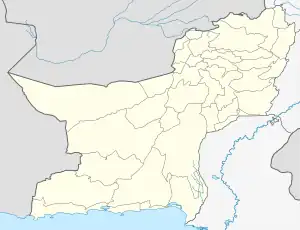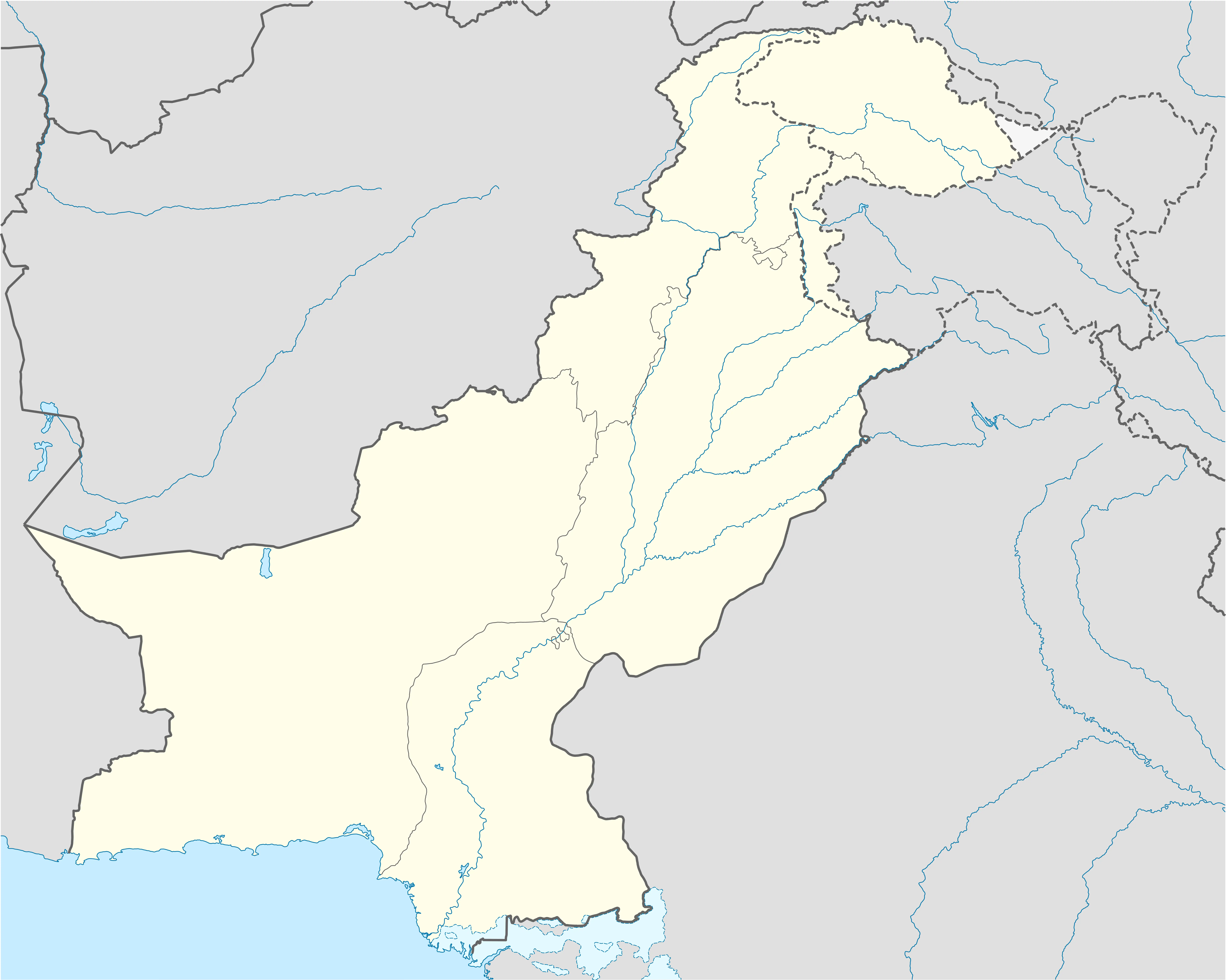Sibi
Sibi (Balochi: سِبّی; Sindhi: سيوي Urdu: سبی;) is a city situated in the Balochistan province of Pakistan. The city is the headquarters of the district and tehsil of the same name.[3]
Sibi
سبی | |
|---|---|
 Sibi  Sibi | |
| Coordinates: 29°33′N 67°53′E | |
| Country | |
| Province | Balochistan |
| District | Sibi |
| Area | |
| • City | 346 km2 (134 sq mi) |
| Elevation | 130 m (430 ft) |
| Population (2017) | |
| • City | 64,674[1] |
| Time zone | UTC+5 (PST) |
| Postal code | 82000 |
| Calling code | 833 |
| [2] | |
Etymology
The origin of the town's name is attributed to Rani Sewi, a Hindu lady of the Sewa Dynasty who ruled Balochistan before the 7th century.[4]
History
The history of the Sibi region dates back to the 7th century at the earliest, when it was ruled by the Sewa dynasty.[4] In the early 13th century, Sibi was a dependency of Multan under Nasiruddin Qabacha of the Ghurid Empire. The area was then variously subject to Multan or Sindh throughout much of its history. The Arghun dynasty of Kandahar invaded in the late 15th century and seized Sibi from the Samma dynasty of Sindh, but it was returned to Sindh during the Mughal period.[5][6] Sibi was governed by the Kalhora dynasty during the early 18th century, which in turn paid tribute to the Afsharids after Nader Shah's invasion in 1737. In 1747, the Durrani Empire assumed control of Sibi[7] and appointed local administrators from the Barozai clan.[5]
Sibi came under the control of the British Crown in 1880, and was an important junction on the Harnai and Quetta loop railway lines.[8] It later achieved independence as part of the new nation of Pakistan in 1947.
Besides the town of Sibi, the district once included the hill station of Ziarat, the summer residence of the government,[9] and the Victoria Memorial Hall, now known as Jirga Hall,[10] which was built in 1903.[11]
Demography
Balochs, Sindhi and Siraiki make majority of the population with Pashto, Brahui speaking balochs and others are also spoken by smaller communities. Urdu serves as lingua franca being the national language.
| Religious group |
1941[13]: 13–14 | 2017[1][14] | ||
|---|---|---|---|---|
| Pop. | % | Pop. | % | |
| Islam |
5,505 | 62.18% | 60,528 | 93.59% |
| Hinduism |
2,814 | 31.78% | 3,506 | 5.42% |
| Sikhism |
362 | 4.09% | — | — |
| Christianity |
171 | 1.93% | 640 | 0.99% |
| Zoroastrianism |
1 | 0.01% | — | — |
| Buddhism |
1 | 0.01% | — | — |
| Total population | 8,854 | 100% | 64,674 | 100% |
Festivals
Sibi Mela is celebrated every February and has been observed since the 18th century.
Climate
Sibi has globally recorded high temperatures, especially in the month of June with an average of 52 °C in the afternoon. Precipitation is light and mainly falls in two distinct periods: early spring in March and April, and during monsoon season in July and August.
| Climate data for Sibi | |||||||||||||
|---|---|---|---|---|---|---|---|---|---|---|---|---|---|
| Month | Jan | Feb | Mar | Apr | May | Jun | Jul | Aug | Sep | Oct | Nov | Dec | Year |
| Record high °C (°F) | 33.2 (91.8) |
33.4 (92.1) |
41.1 (106.0) |
47.0 (116.6) |
51.0 (123.8) |
52.0 (125.6) |
51.7 (125.1) |
48.5 (119.3) |
46.1 (115.0) |
43.9 (111.0) |
40.0 (104.0) |
34.0 (93.2) |
52.0 (125.6) |
| Average high °C (°F) | 22.7 (72.9) |
25.0 (77.0) |
30.9 (87.6) |
37.7 (99.9) |
43.5 (110.3) |
46.0 (114.8) |
42.9 (109.2) |
41.1 (106.0) |
39.8 (103.6) |
37.0 (98.6) |
30.5 (86.9) |
24.5 (76.1) |
35.1 (95.2) |
| Daily mean °C (°F) | 14.1 (57.4) |
16.7 (62.1) |
22.7 (72.9) |
30.1 (86.2) |
35.6 (96.1) |
38.6 (101.5) |
36.3 (97.3) |
34.9 (94.8) |
32.8 (91.0) |
28.0 (82.4) |
21.4 (70.5) |
15.8 (60.4) |
27.2 (81.1) |
| Average low °C (°F) | 5.9 (42.6) |
8.8 (47.8) |
15.0 (59.0) |
22.1 (71.8) |
27.7 (81.9) |
30.8 (87.4) |
29.9 (85.8) |
29.1 (84.4) |
26.2 (79.2) |
19.3 (66.7) |
12.4 (54.3) |
7.0 (44.6) |
19.5 (67.1) |
| Record low °C (°F) | 0.0 (32.0) |
1.0 (33.8) |
3.8 (38.8) |
12.2 (54.0) |
18.0 (64.4) |
23.0 (73.4) |
20.6 (69.1) |
19.7 (67.5) |
15.6 (60.1) |
10.0 (50.0) |
4.0 (39.2) |
−2.3 (27.9) |
−2.3 (27.9) |
| Average precipitation mm (inches) | 6.9 (0.27) |
9.9 (0.39) |
24.7 (0.97) |
14.9 (0.59) |
2.4 (0.09) |
6.0 (0.24) |
35.6 (1.40) |
30.3 (1.19) |
7.7 (0.30) |
1.1 (0.04) |
1.5 (0.06) |
3.3 (0.13) |
144.3 (5.67) |
| Source: NOAA (1971–1990)[15] | |||||||||||||
Notes
- "Final Results (Census-2017)". Retrieved 27 January 2023.
- "Maps, Weather, and Airports for Sibi, Pakistan". www.fallingrain.com.
- "Sibi District UC List, MNA MPA Seats and Profile".
- The tribal Baluchistan by Syed Abdul Quddus page 49
- Khan, Muhammad Jawad. "BHC :: Sibi > History of District". bhc.gov.pk. Retrieved 2017-07-31.
- Davies, p. 627
- Ansari, Sarah F. D. (1992-01-31). Sufi Saints and State Power: The Pirs of Sind, 1843–1947. Cambridge University Press. ISBN 9780521405300.
- "Sibbi Balouchistan Pakistan". Travel and Culture Services. Retrieved 2019-06-27.
- Chisholm, Hugh, ed. (1911). . Encyclopædia Britannica. Vol. 25 (11th ed.). Cambridge University Press. p. 18.
- "Sibi". Government of Balochistan. Archived from the original on 10 March 2012. Retrieved 5 February 2013.
- Encyclopædia Britannica: a new survey of universal knowledge, Volume 3. Encyclopœdia Britannica. 1964. Retrieved 2008-08-17.
Almost all the people are Muslim; the largest Hindu minorities are in the Sibi (9%) and Kalat (2%) districts.
- https://www.pbs.gov.pk/sites/default/files//population_census/results/12711.pdf
- "CENSUS OF INDIA, 1941 VOLUME XIV BALUCHISTAN". Retrieved 27 January 2023.
- "District Wise Results / Tables (Census - 2017) TABLE 9 - POPULATION BY SEX, RELIGION AND RURAL/URBAN" (PDF). Retrieved 27 January 2023.
- "Sibbi Climate Normals 1971–1990". National Oceanic and Atmospheric Administration. Retrieved January 17, 2013.